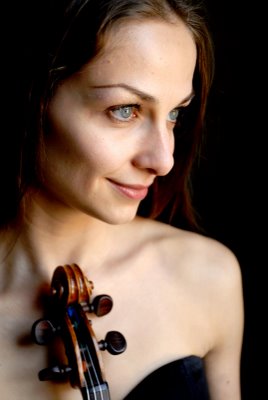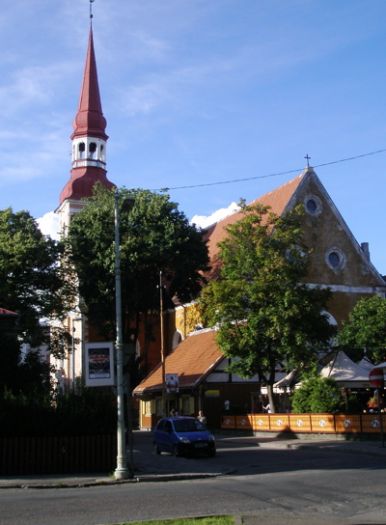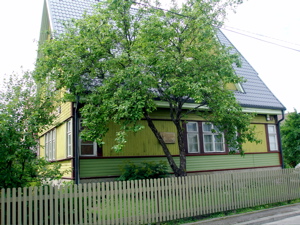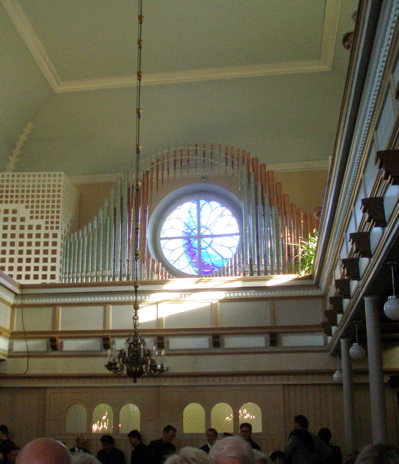Violinist Berman and Tchaikovsky's "Souvenir" salute David Oistrakh's "beloved place"
Mary Ellyn Hutton, Pärnu, Estonia.
Posted: Jul 28, 2008 - 3:52:34 PM in
reviews_2008

Tatiana Berman
|
Pärnu, Estonia.
Always a warm, intimate venue for listening, Pärnu Estonia’s red-roofed, baroque- era St. Elizabeth Lutheran Church (named for 18th-century Russian czarina Elisabeth) was the site of a David Oistrakh Festival concert July 23 by the St. Petersburg Festival Orchestra.

St. Elizabeth Church, Pärnu, Estonia
|
It was the first of two concerts this month led by members of Neeme Järvi's Summer Academy, an annual conducting master course held in conjunction with the Oistrakh Festival since 2000.
Guest artist was violinist Tatiana Berman in Tchaikovsky’s “Souvenir d’un lieu cher,” which was conducted by Academy instructor Paavo Järvi.
Consecrated in 1750, St. Elizabeth Church hosts concerts each summer by the 37-year-old festival, named for legendary Russian violinist David Oistrakh, who summered in Parnu from 1955-70. This year’s festival commemorates the 100th anniversary of Oistrakh’s birth.
There could have been no more fitting tribute to his memory than Russian-born Berman’s performance of Tchaikovsky’s three-part work. Originally for violin and piano (performed here in the arrangement for violin and strings by Alexandru Lascae), it was dedicated to Tchaikovsky’s “beloved place,” his patroness Nadezhda von Meck’s county estate in Poland, where he could spend time composing in the summer.

David Oistrakh's cottage, Toominga St. Pärnu, Estonia
|
Oistrakh's own summer place, a cottage on Toominga St. around the corner from Parnu's famous Tervis Spa, bears a wooden plaque in his memory.
Born in Moscow, Berman trained at the Yehudi Menuhin School (with Menuhin and Natalia Boyarsky) and London’s Royal College of Music (Yossi Zivoni). She plays with exquisite taste, style and precision. Here she brought every facet of the composer’s small gem to light. There were sweetness and purity of tone in the opening “Meditation,” where she climbed to a silvery high D at the end (five ledger lines above the staff). The “Scherzo” was a mini-steeplechase, with her bow bounding across the strings like an agile young filly, engaging in some beautiful dialogue at one point with SPFO concertmaster Alexander Shustin.
The concluding, very familiar “Melodie” was exquisite from start to finish. There was a breathtaking moment at the return of the opening melody where she lengthened the tempo in precise sync with Jarvi and the orchestra. And why not, since Järvi and Berman are husband and wife? A slight misalignment at the pell-mell ending of the Scherzo brought a broad smile from Berman.
The concert began with Mozart’s “Eine Kleine Nachtmusik,” a challenge for any conductor, though some young Academy participants may not have thought so until their stringent rehearsal sessions with Paavo Järvi.
(One young conductor, not among the four below who conducted the work on the concert, was reminded by Jarvi in a rehearsal session: “This is elegant music. It looks more like you’re conducting a Prokofiev scherzo or something toward the end of the 20th century.”)
The four movements were led by Robin Browning of Great Britain, Jerry Hou, a native of Taiwan working in Stockholm and Hamburg, Rachel Young, a New Zealander now in London, and American conductor Sameer Patel.
The program’s “dark” work was Shostakovich’s Chamber Symphony in C Minor, Op.110a, arranged (by Abram Stasevich) for string orchestra and timpani from his String Quartet No. 8. The 1960 quartet has been called Shostakovich’s “musical suicide note.” It is shot through with his musical initials (D E-flat C B for DSCH in German notation) and references to his own works (Fifth Symphony, Cello Concerto, “Lady Macbeth of Mtensk”). The five movements go from depression to abject despair, visiting anger, bitterness and sorrow along the way.
Scotsman Mark Heron, Lehari Kaustel of Estonia and Jean-Philippe Dambreville exchanged batons, sometimes in rapid succession, during the devastating work, with its crushing hammer blows and heartrending laments for cello solo.
Their respective achievements were significant. Dambreville, for instance, a conducting personality in the making, won the hearts of the crowd with his affective conducting of the finale, where he crossed his hands over his heart as he neared the ending. It didn’t hurt, too, that as he acknowledged the applause, he kissed the cellist’s hand, shook everyone else’s in sight, blew a kiss at the orchestra and raised his conducting colleagues’ hands in a kind of victory salute as they shared a group ovation.
This was followed by Benjamin Britten’s “Simple Symphony” ending the concert on a welcome upbeat note. The four movements, “”Boisterous Bouree,” “Playful Pizzicato,” “Sentimental Sarabande” and “Frolicsome Finale” were engagingly led by Shy-Luen Chen of Taiwan, Kaustel, Tim Carey of Great Britain and Kiyotaka Teraoka of Japan.
As is Oistrakh Festival custom, all the performers got roses at the end and rhythmic clapping by the crowd.
Since this observer last visited Pärnu in 2006, a new organ has been installed in St. Elizabeth Church (the Pärnu Organ Festival takes place there each summer) and a round, blue-and-white stained glass window of contemporary design (replacing an earlier traditional one).

rose window, St. Elizabeth Church, Pärnu, Estonia
|
The ceiling has been painted pale blue, complementing the historic brass chandeliers, red oriental carpets and red-cushioned wooden pews.
St. Elizabeth houses the symbol of this old Hanseatic city, the Black Cross of Pärnu, relic of a devastating fire in the 13th century which hangs on the wall next to an altar painting of the risen Christ.



